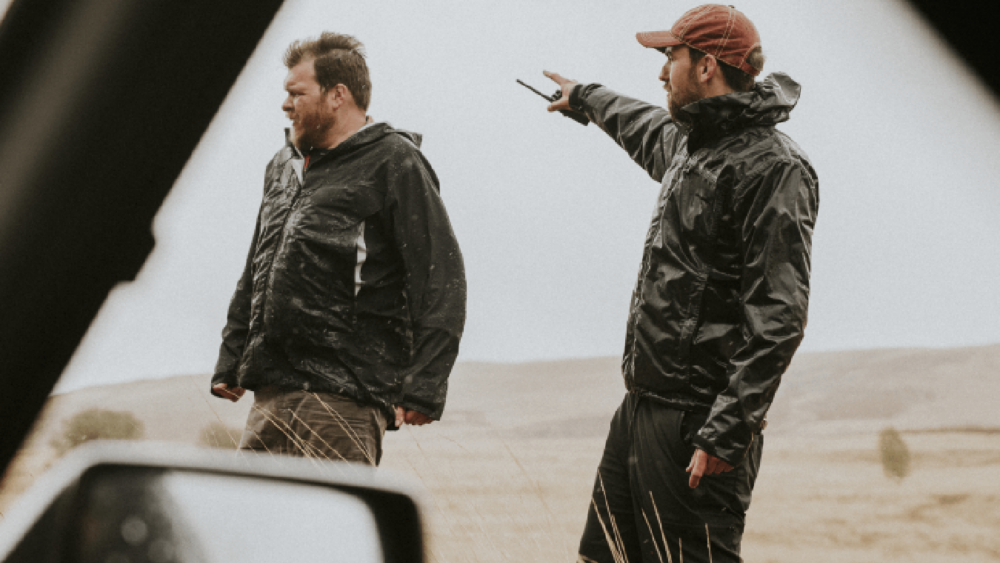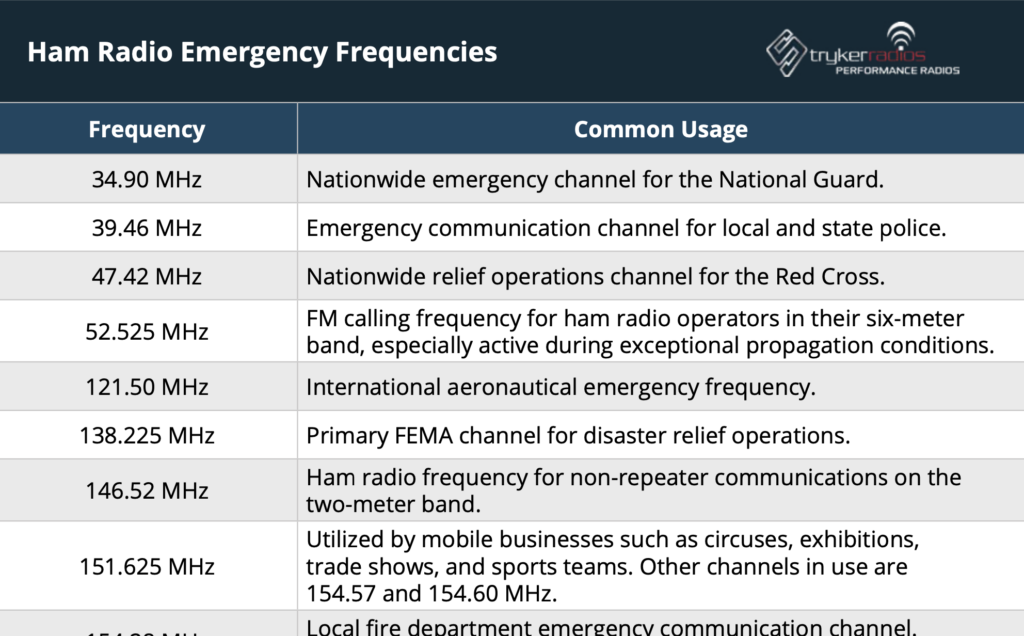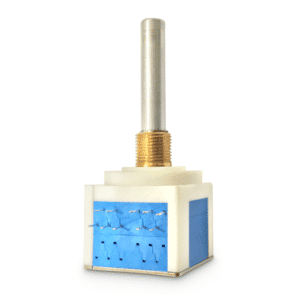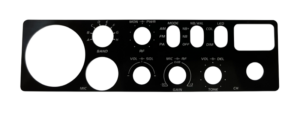Being able to operate a ham radio isn’t just a skill for survivalists, preppers, or first responders. In a situation where usual communication systems fail, anyone can benefit from knowing how to use this important tool. A ham radio can help keep you safe and connected in our unpredictable world, making it a valuable addition to any bug-out bag.
Understanding how to use these radios and their emergency frequencies is a practical skill that could make a significant difference when it matters most. In this article, we’ll cover common emergency frequencies and why ham radios are an excellent resource in emergencies.
Ham Radio Emergency Frequencies
- 34.90 MHz: Nationwide emergency channel for the National Guard.
- 39.46 MHz: Emergency communication channel for local and state police.
- 47.42 MHz: Nationwide relief operations channel for the Red Cross.
- 52.525 MHz: FM calling frequency for ham radio operators in their six-meter band, especially active during exceptional propagation conditions.
- 121.50 MHz: International aeronautical emergency frequency.
- 138.225 MHz: Primary FEMA channel for disaster relief operations.
- 146.52 MHz: Ham radio frequency for non-repeater communications on the two-meter band.
- 151.625 MHz: Utilized by mobile businesses such as circuses, exhibitions, trade shows, and sports teams. Other channels in use are 154.57 and 154.60 MHz.
- 154.28 MHz: Local fire department emergency communication channel. Additional frequencies include 154.265 and 154.295 MHz.
- 155.160 MHz: Local and state agency channel for search and rescue operations.
- 155.475 MHz: Local and state police emergency communication channel.
- 156.75 MHz: International maritime weather alerts channel.
- 156.80 MHz: International maritime distress, calling, and safety channel.
- 162.40 MHz to 162.55 MHz: Series of channels used for NOAA weather broadcasts and bulletins. Also 163.275 MHz.
- 163.4875 MHz: Nationwide emergency channel for the National Guard.
- 163.5125 MHz: National disaster preparedness frequency for the armed forces.
- 164.50 MHz: National communication channel for the Department of Housing and Urban Development.
- 168.55 MHz: Federal civilian agency channel for emergencies and disasters.
- 243.00 MHz: Military aviation emergency channel.
- 259.70 MHz and 296.80 MHz: Frequencies for the Space Shuttle during re-entry and landing.
- 311.00 MHz and 319.40 MHz: Active U.S. Air Force in-flight channels.
- 317.70 MHz and 317.80 MHz: Active channels for U.S. Coast Guard aviation.
- 340.20 MHz: Active channel for U.S. Navy aviation.
- 409.20 MHz: National communication channel for the Interstate Commerce Commission.
- 409.625 MHz: National communication channel for the Department of State.
- 462.675 MHz: General Mobile Radio Service channel for emergency communication and traveler assistance.
Emergency radio frequencies can vary regionally and by organization, so check with local authorities or ham radio clubs for specifics in your area. Also, remember that you must have an amateur radio license to transmit on these frequencies.
Ham Radios & Emergency Communication
Ham radios continue to play an instrumental role in emergency communications for both professionals and amateurs. They provide a range of benefits that cell phones, CB radios, and other communication methods can’t offer.
To use a ham radio, you’ll need to get a license and call sign. Once you have this, we recommend joining a local amateur radio club to refine your skills and practice. To get even more prepared, study the emergency communication protocols. If you’re traveling out of state or out of the country, familiarize yourself with the local repeater directory. You can find more information about US-based repeaters here and in the ARRL repeater directory.
While natural disasters and end-of-world events are often cited as reasons to own a ham radio, there are other more common situations where a ham radio might just keep you safe:
- If you’re hiking and misplace your cell phone, you can use a ham radio to communicate with your family and let them know you’re ok.
- If your car battery dies and you’re out of cell range, a ham radio can help you communicate and get help
- If you need to lay low and don’t want to be tracked via cell phone, you can program a ham radio to pick up radio stations and weather stations so you stay in the loop. You can also communicate when needed.
Ham Radio Benefits During Emergencies
Versatility
Ham radios are versatile in more ways than one. Ham radio operators can access a wide range of frequencies to transmit all over the world. If conditions are right and the equipment is solid, you can reach virtually anywhere with crystal-clear communication.
Using frequencies means ham radios don’t have to rely on cell towers, phone lines, or ISP (internet service providers). Because this infrastructure will likely be down or overused in an emergency, a ham radio is a preferred option. Ham radios can support various modes of communication, including voice, text, and even digital data. Some radios can even send and receive email over radio waves.
Well Supported
The vast community of ham radio operators reaches every corner of the world and has many individuals who are experienced in emergency communication. These operators practice and train for emergency situations and doomsday events, so providing emergency services is part of their skill set.
Solar and Battery Operation
Some ham radios can be powered by batteries or solar power, allowing them to operate even when the electrical grid is down.
Regulation and Organization
Amateur radio is regulated and organized, with operators required to pass an exam to be licensed. This means that there are established procedures for emergency communication. In a chaotic situation, licensure and regulations ensure amateur radio operators communicate effectively during the chaos.
Global Reach
In extreme situations, such as natural disasters that impact an entire region, ham radio operators can reach out to others around the world to share information and request assistance.
Disaster Support
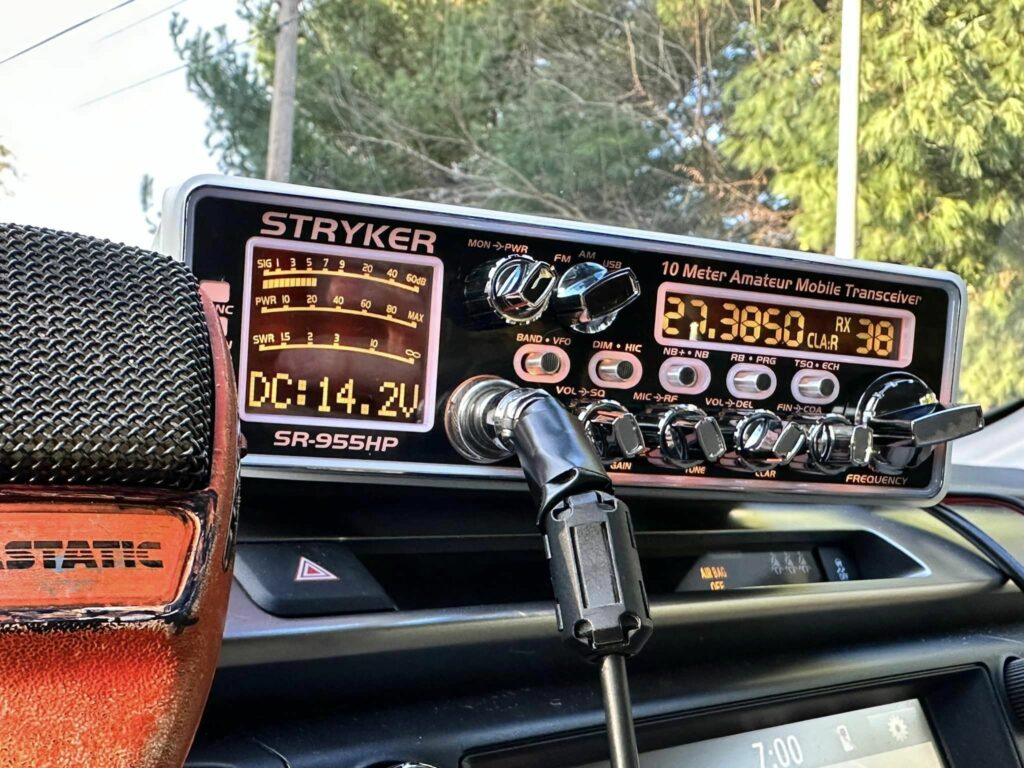 Ham radio operators often volunteer their skills to support disaster response efforts by government agencies, non-profit organizations, and emergency response teams. They often form a “net” on a popular repeater where a moderator will continuously repeat weather updates or other helpful information about the situation. They also allow for call-ins, so anyone who needs assistance can request help.
Ham radio operators often volunteer their skills to support disaster response efforts by government agencies, non-profit organizations, and emergency response teams. They often form a “net” on a popular repeater where a moderator will continuously repeat weather updates or other helpful information about the situation. They also allow for call-ins, so anyone who needs assistance can request help.
For these reasons and more, ham radio has earned a reputation as a reliable means of emergency communication and continues to be a valuable resource in disaster preparedness and response.
Ham Radios & High Frequencies
HF (High Frequency) Radios
In the event your entire region, state, or even country is struck with a disaster, you’ll need an HF radio to get the job done. HF (high frequency) radios can communicate over long ranges, reaching cross-country and even around the world.
To use the HF frequencies, you need to upgrade your operator license to a General level. You’ll also need to invest in new equipment like a base station, tuner, and backup power solutions like batteries, generators, or solar power.
UHF/VHF
These radios are another great option for emergency situations. UHF (ultra-high frequency) radios work both indoors and outdoors and can penetrate both concrete and steel. VHF (very high frequency) is meant for the outdoors and doesn’t penetrate buildings very well. It’s commonly used with boaters.
They don’t transmit quite as far as HF radios, but they are capable of handling higher amounts of data and giving clearer communication.
What About CB Radios and GMRS/FRS?
CB (Citizen’s Band) Radios were designed to be used for short-distance communications. They’re most popular with truckers, who have used them for decades to report on traffic, weather conditions, and other helpful information. They don’t require any kind of license and are only lightly monitored by the FCC.
CB radios are not meant for emergency communication because they’re short-range, low-power, and can only communicate on a select number of bands. You can use an SSB (single side band) CB radio to transmit out ~20 miles, but it requires communicating with another SSB CB to be effective. However, like ham radios, they don’t rely on cell coverage to transmit, so a CB could be useful when nothing else is available.
FRS (Family Radio Service) and GMRS (General Mobile Radio Service) radios are common types of radios as well. The GMRS and FRS frequency range is 462 MHz to 467 MHz, and it’s divided into channels. Additionally, GMRS radios require a license to use, while FRS radios do not. These devices are primarily used for short-range communication, so their use in emergencies is more limited than 10-meter radios.
Conclusion
To sum up, ham radios play a vital role in emergency communication, especially when regular methods like cell phones and the internet fail. These radios can work without relying on any existing infrastructure, making them ideal in disasters like earthquakes or hurricanes. The community of ham radio operators, trained through licensing processes, are often the first to provide critical communication during emergencies. Despite being seen as old-fashioned, the value of ham radios remains high. They are not just a link to our past but a vital tool for handling future challenges.

